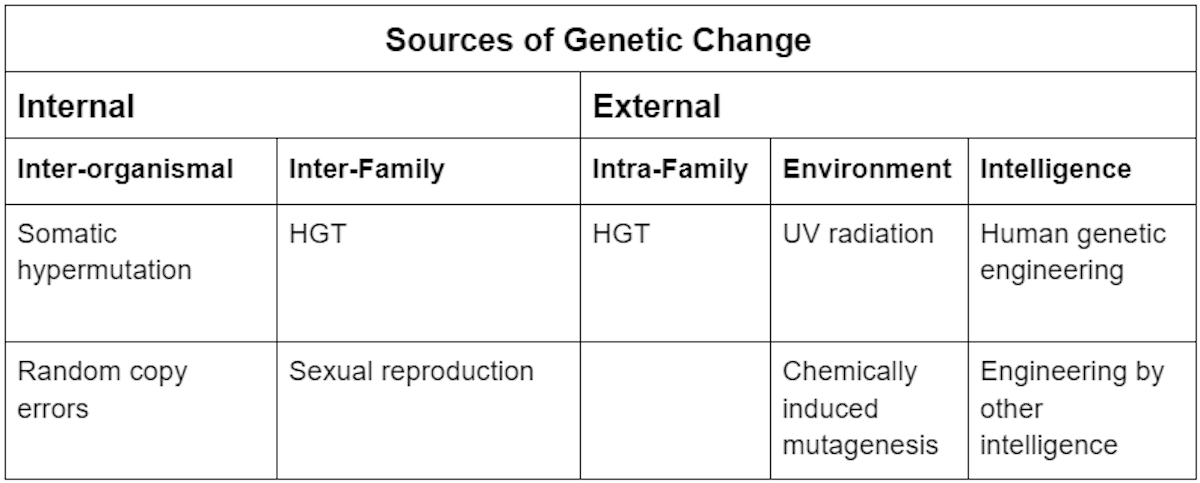Examining Sources of Genetic Change
- Emily Reeves
Understanding causes of genetic change (what we usually think of as “mutations”) is very important. Sometimes genetic change is caused by an error-prone polymerase or a programmed gene reassortment. Other times it is caused by UV radiation, a chemical, or a virus inserting some of its DNA into the DNA of another species. Genetic change through time, or evolution, is a matter of much debate. To bring clarity to this debate, the key is to first understand the sources of genetic change.
Eric Bapteste, a researcher at Sorbonne University, just co-authored a review in the journal Ageing Research Reviews. The review discusses genetic change in the context of aging. He and his coauthors emphasize that aging in one species may be controlled by an “age distorter,” often a bacteria or virus. (Teulière, Bernard, and Bapteste 2021) The paper also does a fine job of discussing the importance of thinking about sources of genetic change. I thought it would be appropriate to consider how these topics relate to intelligent design.
To give a bit of an outline, today I will discuss gaps in mainstream discussions about genetic change and explain how Bapteste’s recent publication highlights a gap. Then I will share an organizational framework for thinking about different types of genetic change. In a post tomorrow, I’ll give a bird’s-eye overview of Bapteste’s paper. There will be discussion about what different types of genetic change can and cannot account for in terms of novelty from an ID perspective. Finally, I will emphasize that an intelligent design model provides plausible explanations of genetic change that are helpful as a competing hypothesis, consistent with experimental observations of intelligent agents causing genetic changes or writing computer code.
Is Mainstream Thinking about Genetic Change Adequate?
Bapteste et al. point out in the introduction that it has long been assumed that the units of selection are individual members of the same species. But if external sources, viruses for example, contribute to genetic change and therefore fitness, then units of selection could also be external to the species. While Bapteste’s paper focuses on specific aspects of genetic change (I’ll get into this a bit more later), he seems to hint at broader gaps in current mainstream thinking. For instance, by drawing attention to this specific example of external genetic change and aging, he helps us recognize that different sources of genetic change are not being considered when variation is observed. This provides a stepping off point for discussing how genetic change is often not assigned to a source and the importance of moving towards more assignment. Unassigned genetic variation (no cause or source) is sort of like a blank check. One can fill in the blank with any source, but that may result in the over-crediting of certain mechanisms and under-representation of others. As only some mechanisms can give rise to genetic novelty, over-crediting could lead to inaccurate account of the history of life.
From an ID perspective, it is crucial to classify which sources of genetic change can account for the arrival of genetic information. This step can only really happen after the source of genetic change has been determined. Untangling the source may not be easy but science demands that we try. The first step might be describing and organizing different sources of genetic change.
An Organizational Framework for the Cause of Genetic Change

Categorizing the source of genetic change as internal or external can help avoid conflating different types of genetic change (see Table 1 for details). Here I define internal as referring to genetic change caused by either a mechanism within an organism (i.e., programmed somatic hypermutation) or a mechanism between organisms (i.e., sexual reproduction or HGT) up to the taxonomy of family. Internal genetic change within an organism may be intentionally programmed by the organism such as is in somatic hypermutation where programmed mutations across hypervariable regions of immunoglobulin genes allow for increased recognition of foreign antigens. (Di Noia and Neuberger 2007) Alternatively, internal genetic change within an organism may be a random copying error caused by a malfunctioning polymerase. HGT or sexual reproduction between organisms up to the taxonomy of family is also considered internal genetic change under this organizational scheme.
In my table above there are three major sources of external genetic change. One would be when an organism exchanges genetic information with another organism outside the taxonomy of family (the category investigated by Bapteste’s paper). Another source of external genetic change would be when the environment induces a mutation in an organism. Finally, a third source of external genetic change is when an intelligent agent causes genetic change (e.g., genetic engineering in the lab).
Organization can help to avoid conflating different types of genetic change which may prevent oversights for how genetic change and natural selection cooperate. Establishing an organizational framework for thinking about genetic change helps to avoid conflating different types of genetic change. It may also lead to insights about how such change cooperates with natural selection. Tomorrow I will turn to the specific example of external genetic change that Bapteste describes. I will then consider, from an ID perspective, this type of genetic change and its limits for accounting for the origin of genetic information.
Next, “Eric Bapteste on External Genetic Change In ‘Age-Distorters.’”
No comments:
Post a Comment